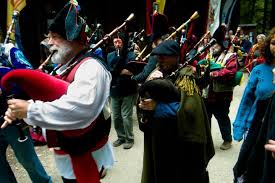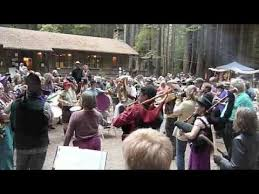By Kevin Carr
My first trip to Galicia, an autonomous region in the northwestern corner of Spain, was in 1978. I had recently become fascinated by the world of bagpipes and had read in Baines’ book (Bagpipes, Anthony Baines,1995, Pitt River Museum, University of Oxford) that there was a bagpipe museum in Northern Spain. So when I found myself in Santiago de Compostela, capital of Galicia, I assumed that this was where the museum would be located. After asking excitedly in deeply flawed Spanish about the location of the bagpipe museum, and being met with confused looks, I suddenly heard the unmistakable sound of piping. Dropping my backpack I ran around a corner and was overjoyed to see a traditional group of 2 pipers, gaiteiros, a bass drummer, a small snare drummer and a man playing pandeireta, the small tambourine played virtuosically in Galicia. I was beside myself. I ran up to the leader of the group, and in that eloquence that is occasioned by a mixture of musical intoxication, ignorance of the language and the need to speak or explode, managed to say, in English, “bagpipes!!!!!”. The man, who, like all the others was in traditional costume and looked marvelous, looked at me and asked me where I was from. Though he spoke in Gallego, I somehow understood, and said, ” the USA”. He then asked me if I knew a man named Bruce. And he did an imitation of the way Bruce walked. And, now, gobsmacked and stunned by this further turn of events, I realized that I did indeed know Bruce. “I know Bruce!” I exclaimed, and without changing expression, this man reached in his pocket and pulled out a small package, which he handed to me. ” This is a package of Gaita reeds, for Bruce. You will deliver them. Now come. We go to play.” And they struck up and led the way to a plaza, where it seemed people came out of each doorway and began to dance to the music. They danced the muiñeira, a 6/8 dance which is lovely to behold. Old and young alike danced. I was in love. I spent 24 hours in the company of this group, though it felt like a month, and I have loved Galicia ever since.
Traditional Gaitas had one drone and a chanter. Every region in Galicia would have traditions of ornamentation, intonation, pitch and certain tunes unique to the area. Galicia is deeply rich in folk music, song and dance, and though there have been periods in history where there was much pressure on the tradition (emigration, war, Franco’s disdain for regional customs) the music has persevered. Today there are more than 90,000 pipers in a country, Galicia, of 2.5 million people. That is an admirable percentage. There has been much progress in pipe making, with various drone configurations, new tonalities and refined chromatic abilities for the chanters. Makers like Seivane, Varela, Oli, Mouriño and many more work to the highest standard producing jewel like instruments
In 2002 a dear friend and fellow bagpipe collector and player, Ian Law, phoned me with a scheme. He thought we should order a group of very high quality gaitas from the Seivane family, the most celebrated pipe makers in Galicia – the idea being that if a number of us ordered them, we would be taken more seriously. Since I had the most Spanish, I was elected to make the call, which I did. We had rounded up five folks who were interested, and I was told we would have our pipes in one year. About six months later I was playing at a Celtic festival in Sebastopol, California and I saw a man who was carrying a gaita identical to the ones we had ordered from Seivane. I complimented him on his gaita, and he was surprised that I knew what it was. I said that we had ordered pipes just like it and were expecting them in a few months. He laughed and explained that the Seivanes were often a bit late in delivering on orders (which might have been the case then, but certainly is not these days!). But he gave me his card and said that should I ever need any help with matters Galician I should give him a call. He was Gallego through and through, and a very kind man, Manuel Torres.
A few months later the California Revels, a theatre troupe which puts on mighty Solstice pageant each December, and with which I had worked several times, approached me about doing a “Galician” Revels. I remembered Manny’s card, and he proved more than helpful, with books on traditional costumes, repertoire suggestions, and in fact he ultimately appeared in the show with me. More to the point, he suggested we might invite a dear friend of his, and very experienced gaita teacher, Alexandre ‘Cano’ Cadarso to come and give us a workshop. He said that Cano was also a dear friend of the Seivanes, and could perhaps nudge them a bit about our pipes. Cut to the chase, and several months later Cano arrived in San Francisco with five beautiful gaitas. He gave us a wonderful workshop and I arranged several concerts for him, and in short order we realized we were brothers of the bagpipe, so I invited him back the following summer to teach Gaita at Lark Camp in the Woodlands near Mendocino, California. That was the start of a beautiful friendship. Under Cano’s tutelage that summer and many succeeding summers, a west coast Gaita scene was born and grew. We now number 15-20 gaiteiros from Seattle to San Diego. There are a number of YouTube videos of our playing, as a group, and with a brass band in a combination that has proved very popular each year at camp. Several years ago we organized a Gaita Intensive for two days after Lark and it was heaven on earth. We are aiming for that again in the summer of 2016, for two days during the week after Lark Camp. Anyone interested is welcome to contact me. Fun will be had.
Elsewhere in North America, there is a gaita group in Florida, and another in New Jersey, associated with Galician Cultural centers. I do not know much more about them. There is a website concerning Spanish bagpipes in the USA. In addition to the Galician gaita, which is the most numerous on the Iberian peninsula, there is the Aragonese Bota, the Sac de Gemecs of Catalunya and Mallorca, the Asturian gaita, and gaita Sanabresa, as well as the gaita de fol in the Mirandesa region of Portugal.
Rob Gandara is the only gaita maker I know of in the USA, and he is in Corvallis Oregon. He makes nice instruments out of carbon fiber.
As far as festivals go there is Larkcamp, which I previously mentioned. I have played my gaita at many festivals and dance festivals around the country with the groups Wake the Dead (self described as the World’s First Celtic All-Star Grateful Dead Jam Band) and Hillbillies from Mars (gaita solo at 7 min. into this video). There are informal festivals in Berkeley California and Kingston Washington, called Magostos, which center on playing the gaita, dancing and eating roasted chestnuts. I have done small workshops on gaita and Galician music at Alasdair Fraser’s Sierra fiddle camp and Festival of American fiddle tunes.
About Kevin Carr : I fell in love with the sound of the uilleann pipes during a trip to Ireland in the mid seventies, and tried with great difficulty to get a set. My sister, feeling my pain, found a Highland bagpipe with which to console me, so I began lessons with the daughter of a Canadian pipemajor. I did find a practice set of Irish pipes and began the long journey. These are still the pipes I play most often. But as I learned of the central role pipes played in so many cultures, for so many centuries, I was drawn to make those ancient sounds come alive myself. I now have a stable of around 25 bagpipes, representing the major regional types of the instrument. I do presentations and demonstrations of bagpipe history whenever I can, and often feature bagpipes of various types in the storytelling shows I do. I also play fiddle and various string instruments, and play them all in a yurt at the far end of my country acre so my marriage can thrive.

